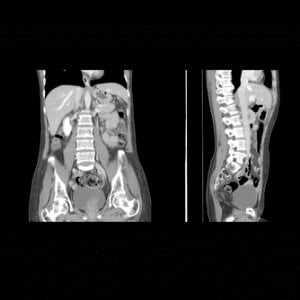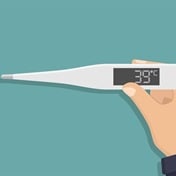
Alternate names
CAT scan, computerised tomography, scan
What is CT scan (abdomen)?
CT scan is an imaging modality which uses special X-ray equipment to produce multiple pictures of the inside of the body. These are then joined together by a computer to produce cross-sectional views of the area being studied, in this instance, the abdomen. The images are then examined on a computer monitor or printed.
The CT scanner is a large machine with a tunnel, in the centre. A moveable table slides into and out of this tunnel. In the centre of the machine, the X-ray tube and electronic X-ray detectors are located opposite each other on a ring which rotates around you, measuring the amount of radiation being absorbed throughout your body. A special computer programme processes this information to create two-dimensional cross-sectional slices of your body, which are then displayed on a monitor.
Common uses
In all cases where injury or disease of the organs inside the abdomen is suspected. Most commonly used for diagnosis and staging of cancers, location of renal stones and fluid or pus collections in the abdomen.
How should I prepare?
Abdominal CT scan requires the administration of oral, often rectal and intravenous dye (contrast). It is essential that the bowels be clean for the procedure and to ensure this you will be given four litres of laxative solution and will have to fast for 24 hours before the examination. To be able to obtain good quality images you need to follow instructions on preparation carefully.
You will be given a gown to wear during the examination, but wear comfortable, loose-fitting clothes just in case. Metal objects including jewellery and belts should be removed and keys taken out of your pockets as these may affect the CT images. Women should always inform their doctor or the radiographer if there is any possibility that they are pregnant. Because of the potential damage that contrast can cause to diseased kidneys, you should inform your doctor if you are a diabetic, suffer from high blood pressure, or have other kidney diseases. It is also essential to mention if you have suffered previous reactions to contrast.
How is the procedure performed?
Before the examination you will be asked to drink contrast and might be given a contrast enema. You will also have a needle inserted into your arm or hand for intravenous (vein) contrast.
The radiographer will position you on the CT examination table, usually lying flat on your back. Straps and pillows will be used to help you maintain the correct position and to hold still during the exam. Next, the table will move quickly through the scanner to determine the correct starting position for the scans. Then, the table will move slowly through the machine as the actual CT scan is being performed. With modern scanners the examination time for the abdomen CT depends on the organ being investigated and can take as long as 10-15 minutes. If you are claustrophobic or restless, you may find a CT exam to be stressful, and might be given a sedative. You will hear only slight buzzing, clicking and whirring sounds as the CT scanner revolves around you during the imaging process.
You will be alone in the exam room during the CT scan, however, the technologist will be able to see, hear and speak with you at all times. With paediatric patients, a parent may be allowed in the room, but will be required to wear a lead apron to prevent radiation exposure.
Risks
Cancer due to radiation is always a risk, but the radiation from a CT is less than a normal person receives from background radiation (cosmic rays from atmosphere) The benefit far outweighs the risks.
Risk is increased for the babies of pregnant mothers, so please inform your doctor prior to the examination if you may be pregnant. Whenever possible, shielding of gonads to protect from radiation is advised.
Repeated examinations on children should be avoided.
Modern contrast agents have minimal risk of allergic reactions, although diseased kidneys could be further damaged especially if you are dehydrated. Make sure that you drink at least 2 litres of water on the day of and after the examination.
Limitations
Obese people might not fit on the scanner.




 Publications
Publications
 Partners
Partners















